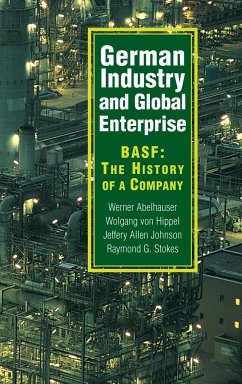This book examines the way in which BASF functions, delving into its corporate governance, financial system, industrial relations, systems of qualification, and relation to other companies in the same sector and to the economy at large. The structure of BASF's social system of production and its change through time are central themes of each of this book's four chronologically organised sections. The corporate history of BASF offers far more than just a glimpse into the functioning of an industrial organisation that has held its own on the market since 1865. It reveals a good deal about the reasons for the extraordinary economic dynamics of the German empire and the enormous expansion of the world economy before World War I. By the same token, BASF's history stands at the centre of Germany's wartime economy during both world wars and highlights both its strengths and its weaknesses.
Table of contents:
Introduction; Part I. Becoming a Global Corporation - BASF from 1865 to 1900 Wolfgang von Hippel: 1. The prehistory; 2. The early years (1865-1873); 3. Between science and the marketplace - BASF in the 'Dyestuffs Age', 1973-1900; Part II. The Power of Synthesis (1900-1925) Jeffrey Allen Johnson: 1. A company in transition; 2. From Dreibund to von Brunck's death (1904-1911); 3. From Oppau to Leuna: synthetic ammonia and war (1912-1918); 4. From crisis to fusion (1919-1925); Part III. From the I. G. Farben Fusion to the Establishment of BASF AG (1925-1952) Raymond G. Stokes: 1. Introduction; 2. Fitting into the new concern, 1925-1929; 3. Coping with the crisis, 1929-1933; 4. Accommodation and conflict, 1933-1936; 5. Autarky and the preparation for war, 1936-1939; 6. The Upper Rhine group in German-dominated Europe, 1939-1942; 7. The BASF group in total war, 1942-1945; 8. From occupation to refounding, 1945-1952; Part IV. BASF Since its Refounding in 1952 Werner Abelshauser: 1. The past has a future: launching BASF anew; 2. Corporate culture: tradition as a resource?; 3. Old markets, new basis: early breakthrough to petrochemistry; 4. Tradition and distance: the second break-up of I. G. Farben; 5. The way to the top: strategic decisions; 6. One, two, many 'Ludwigshafens': the integrated production system and the siting issue; 7. Learning from the United States? From joint venture to Verbund; 8. Crisis and consolidation; 9. No weary shop of raw materials: forward integration and acquisition; 10. Upheaval and persistence.
This is a corporate history of BASF, which also explores the reasons for the extraordinary economic development of the German Empire, its role in supporting the German economy during two world wars, and its position in facilitating West Germany's quick return to the world market.
Corporate history of BASF, which also explores the reasons for Germany's extraordinary economic development.
Table of contents:
Introduction; Part I. Becoming a Global Corporation - BASF from 1865 to 1900 Wolfgang von Hippel: 1. The prehistory; 2. The early years (1865-1873); 3. Between science and the marketplace - BASF in the 'Dyestuffs Age', 1973-1900; Part II. The Power of Synthesis (1900-1925) Jeffrey Allen Johnson: 1. A company in transition; 2. From Dreibund to von Brunck's death (1904-1911); 3. From Oppau to Leuna: synthetic ammonia and war (1912-1918); 4. From crisis to fusion (1919-1925); Part III. From the I. G. Farben Fusion to the Establishment of BASF AG (1925-1952) Raymond G. Stokes: 1. Introduction; 2. Fitting into the new concern, 1925-1929; 3. Coping with the crisis, 1929-1933; 4. Accommodation and conflict, 1933-1936; 5. Autarky and the preparation for war, 1936-1939; 6. The Upper Rhine group in German-dominated Europe, 1939-1942; 7. The BASF group in total war, 1942-1945; 8. From occupation to refounding, 1945-1952; Part IV. BASF Since its Refounding in 1952 Werner Abelshauser: 1. The past has a future: launching BASF anew; 2. Corporate culture: tradition as a resource?; 3. Old markets, new basis: early breakthrough to petrochemistry; 4. Tradition and distance: the second break-up of I. G. Farben; 5. The way to the top: strategic decisions; 6. One, two, many 'Ludwigshafens': the integrated production system and the siting issue; 7. Learning from the United States? From joint venture to Verbund; 8. Crisis and consolidation; 9. No weary shop of raw materials: forward integration and acquisition; 10. Upheaval and persistence.
This is a corporate history of BASF, which also explores the reasons for the extraordinary economic development of the German Empire, its role in supporting the German economy during two world wars, and its position in facilitating West Germany's quick return to the world market.
Corporate history of BASF, which also explores the reasons for Germany's extraordinary economic development.








